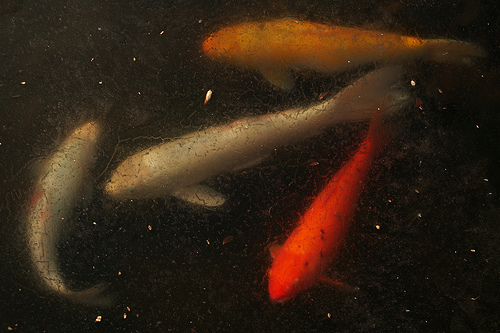
THE BIG QUESTION:
What happens to koi and goldfish during the winter months? This is a common question and concern that many pond keepers have. Warm weather is obviously the best time to enjoy koi and goldfish keeping. During this time koi and goldfish are active, lively, and highly visible. Many koi and goldfish become downright interactive with pond keepers. Koi and goldfish will follow the pond keeper around the pond. They will even stick their faces out and practically climb out of the pond to celebrate feeding time. During this time we know is exactly what is going on with our fish. A quick peek in the pond tells us everything.
CHILLING OUT:
Then the cold weather sets in. Snow, ice, shorter days, and more indoor time leads to our slowly losing our ability to see what’s happening with our pond fish. These conditions can last for many months depending on your location. Once the ice and snow come; well, we lose touch with our fish. So what’s going on underneath those layers of ice and snow? What are our fish up to? Are they missing us? To most pond keepers this time of year is simply a mystery. We wait, sometimes with great anxiety, for the spring thaw so we can once again connect with our koi and goldfish. What’s going on under the ice and snow?
THE COLD HARD FACTS:
Here are some facts about Koi and goldfish. Koi and goldfish are poikilothermic animals, a fancy way of saying cold-blooded. This basically means that their body temperature is regulated by the surrounding temperature of the water. In turn, their body functions respond and change according to the water temperature. The activity level slows down. They tend to keep themselves concealed when concealment is available. Rate of metabolism for koi and goldfish is greatly reduced during low water temperatures, especially below 50F. This is why they do not feed during the cold periods, when water temperatures drop and stay below 55F. Koi go into a state of torpor.
Torpor is not quite full hibernation, it is of a shorter duration than hibernation. Otherwise it is a very similar state of being: lower body temperature, reduced heart rate, slowed metabolism, slow reaction times, reduced breathing rate and primary body functions. Torpor allows the animal to save the energy that would otherwise be needed for higher levels of activity. Torpor can take some time for koi and goldfish to snap out of as well. If torpor needs to be broken try to do it with finesse. Many experts say that because koi and pond fish are cold water fish (non-tropical) they actually benefit from a cold period. However; prolonged and extended cold spells, and dark, are not good for them. During these prolonged cold spells they run the risk of their immune systems greatly weakening or shutting down.
WHAT ARE THEY DOING??
In short our fish are not up to too much under the ice and snow, sorry, but keep reading anyway. Our koi and goldfish not being up to too much is an interesting behavior, considering how lively they are throughout the rest of the year. For the most part they sit on the bottom of the pond in the “warmest” pocket of water they can find. During winter months the warmer water is on the bottom of the pond. During warmer months its inverses with colder water at bottom of pond and warmer water up top. I have often seen my koi lined up next to each other, evenly spaced, facing the same direction; as if they were in a parking lot! This funny behavior that may lead a pond keeper to think koi and goldfish are huddled together to share body heat; but koi are poikilothermic, so no. This behavior is probably a way to fit as many koi into that pocket of warm water as possible. In larger warm areas you’d probably see a more random formation of the koi, some facing this way and others facing that way.
There will be some activity but this is all temperature dependent. When water temperatures are between 45F – 55F koi and goldfish will still slowly mill around in the pond. They will still take some time sunning themselves when conditions allow as well. Once water temperatutes dip below 45F they will remain pretty still, even on sunny days. Although we do not and should not be feeding doesn’t mean that there is zero sustenance being taken in. This time of year koi and goldfish will still casually scrape the highly nutritious algae from rock growth below water for a bit of calories and energy. Because of the state of being in torpor it is a very good idea to keep things as calm as possible around the pond.
DON’T BE LEFT OUT IN THE COLD:
Keep an area of ice open as much as possible by using a floating or sinking de-icer and/or an aerator. This open area in the ice will allow gases to escape the pond and oxygen to get in more efficiently. If you need to open the ice in the pond find a quiet way to do it like using boiling water to open a hole if the ice is thin enough. Don’t chop or break ice open with a pick ax or hammer! Most pond pond professionals will use a hand held drill with a hole saw to open ice. This approach is actually pretty quiet compared to other methods. If your a pond keeper the hole saw is a great tool to have. Some people add salt to their ponds. I personally am not a practitioner of adding salt unless it is for treatment purposes. If you do add salt to your pond you should dilute your salt levels during cold winter months. Higher salinity can make your pond water’s freezing point drop to below 32F which can kill your fish. Generally speaking you should not let your pond water’s temperature drop below 34F. Temperatures below 34F will allow ice crystals to form on the gills of your koi and goldfish, which can kill them, so watch the temperatures if you live in an area of extreme winter temperatures.
THERE IS A NIP IN THE AIR:
Really. Winter is still prime time for predators of our koi. Torpor make our koi and goldfish very easy targets. Some brutal predators like mink and the great blue heron have no issue hunting our frozen ponds. When conditions allow try to keep a count of your koi and goldfish. It would be prudent to set up predator controls for your pond.
PLAY IT COOL:
If a pond was cleaned and prepped prior to those cold dark winter months, then worry not, koi and pond fish should do just fine. Like mentioned the koi and goldfish in your pond do not DO much during the winter months. Spring will be here soon enough and your fish will start again with their antics and amusing behavior. But for now you have a better idea of what is happening out there under the ice and snow, and you are not missing out on any party. If only we all could share that state of torpor and wake again when the spring has sprung!
All copyrights to this material belong to Mike Gannon.
